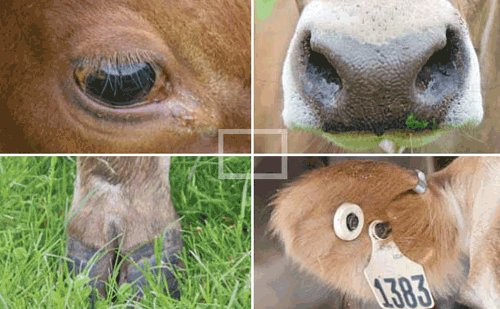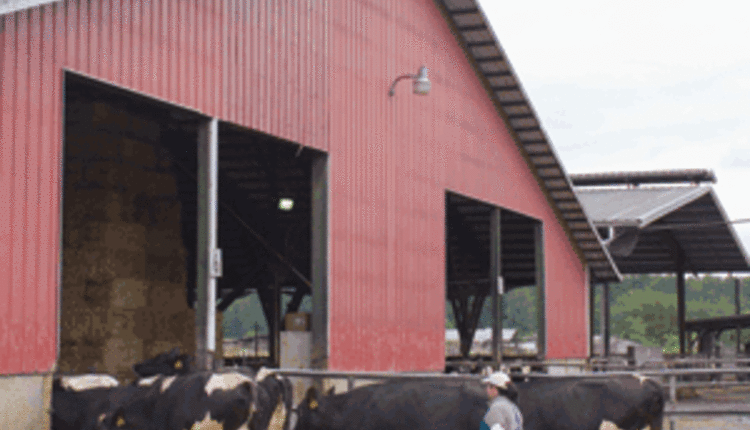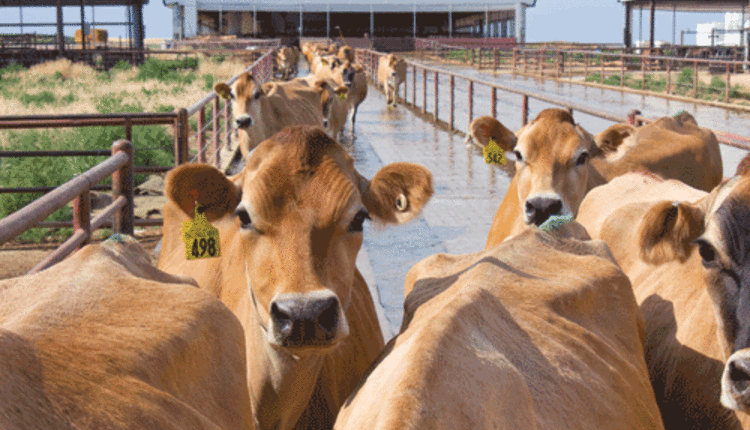Thomas is an author of many livestock books and owns a beef cattle herd with her husband in Salmon, Idaho. She wrote this series with Paul Rapnicki, D.V.M., formerly with the University of Minnesota School of Veterinary Medicine (UMN-SVM); Don Höglund, D.V.M., currently with the UMN-SVM; and Margaret Perala, D.V.M., with Vet Services of Deerfield, Kan

Handling cattle efficiently and with limited stress to the animals and handlers is both an art and a science. Every interaction between humans and cattle shapes the future behavior of those cattle. The handler must become aware of his/her actions and realize the impact on the cattle. A good rule is to think before you act. Think about what the cow is doing (or not doing) and how you need to act in order to influence her. The cow is the starting point, not the human. Your actions must be generated/sculpted to fit what will best serve to produce the desired reaction from that cow. The handler adjusts his/her movements to whatever that cow needs in order to obtain the desired results.
All five senses are in play
Science has shown us that cattle react to the world around them in response to the information they receive from their five senses: sight, hearing, touch, smell and taste. They see herd members' actions, hear their calf bawling, will often touch and taste first when examining something new and smell one another for individual recognition. For sexual interactions, the bull determines a cow's receptiveness for breeding by the odors he detects in her urine, feces, sweat and breath. A young calf is curious, experiencing through all of her senses.
If we want to communicate with cattle, we must do it through their senses. The two most important senses cattle use for self-preservation (as herd animals) in interpreting what's happening in their environment are sight and sound. Unexpected movement, noises or touch may cause a cow to startle. For example, quick movements, loud noises or hitting may surprise cows.
A surprised animal may react explosively or in some other negative way, and we've lost our opportunity to handle her efficiently. It may take 30 minutes or more before she settles down again. Anxious cattle take longer to "settle" than calm livestock. Calm cows are more receptive to what we want them to do. We should concentrate on how our actions influence cattle movement and curb any inclination to yell, poke or shock. Then, we can direct her actions by our position and movement in relationship to her.
Key stockmanship principles
With eyes positioned near the side of the head, a cow has excellent peripheral vision and only a small blind spot directly behind her. In general, if you can see her eye, she can probably see you. Since cattle usually look and listen at what's pressuring them, approach a cow from a position where she can see you.
Never try to drive cattle from directly behind because you would be in their blind spot, causing them to turn and face you. To keep cattle moving, always move a little off to the side, and never follow directly behind. In order to keep an eye on a person, cattle tend to move in an arc around the person who is pressuring them.
Cows also tend to follow other cattle, return to where they came from and move in the direction they are facing. You can use these behavioral tendencies to your advantage when moving cattle, emptying a pen or loading a chute or truck. If the handler can create forward motion at the front of the herd and then avoid doing anything that will slow or halt that flow, the cattle will keep following the animals in front of them.
Always pay attention to your own position in relation to all of the cows. It is very important to make sure you avoid pressuring cows inefficiently. Cows often respond negatively to overpressure such as shouting, running, arm waving, hitting them or using electric prods to stimulate them to move. These high-stress tactics are counterproductive because the animals may try to get away from the pressure - running away or running back over the handler if they perceive no other way to escape.
Pressuring a cow efficiently involves proper speed, timing and angle of approach. There is no magic formula. Each time you handle cattle the animals' behavior will inform you if the angle, speed and timing of your approach are correct. If a cow doesn't respond the way you want her to, back away (along the same line/angle as your approach) and try again - changing the angle and speed of approach.
To start a group of cows moving generally takes a little more coercion than to keep them moving. Once they start moving, you can back off a bit and give them more space or pause momentarily to create more distance between you and the moving cattle. Apply pressure again only if they begin to slow or stop, keeping just enough pressure to keep them walking calmly.
Don't overpressure when trying to start them moving (or to keep them moving), or they may overreact and try to run away. Young animals are easier to stimulate because they are not yet familiar with being handled (not yet "trained"), and you must be extra careful to pressure them properly.
We move at different speeds
If you are moving a group of cows and trying to keep them going, remember to walk slowly. Cows walk at about two miles per hour, compared with humans walking about three to four miles per hour. If you walk at normal speed parallel with the cattle, you'll overtake the leaders which will slow them down and eventually stop them. Try to walk the same speed as the cows, keeping your pressure position where it needs to be. Always be careful not to apply too much pressure. Generally, it's best if only one person is applying pressure and moving the cattle. If more than one person applies pressure, the potential exists for the pressures to be contradictory. Contradictory pressures produce incompatible behavior resulting in confusion.
A key tenant of dairy stockmanship is to be calm, consistent and observant of what is going on around you. Another way to put this is to "see everything while looking at nothing." If you are always paying attention to the cattle, they will always tell you what your next actions should be. Yet, all of this observation should be nonintrusive, nonconfrontational. Cattle tend to relax if you are relaxed.
Dairy stockmanship is the recognition of human/cattle relationships with the goal of reconnecting the people with the cows with a positive outcome. The staff at University of Minnesota College of Veterinary Medicine has developed a program of dairy stockmanship to help dairy workers understand and practice these concepts. The goal is to build an understanding for the animals, increasing our powers of observation - and enabling us to use these observations to "do the right thing" in every situation.
The "Introduction to Dairy Stockmanship" training module was developed in conjunction with Merck Animal Health. To request a copy of the module, contact your Merck Animal Health representative, email info@DairyCare365.com or contact the University of Minnesota College of Veterinary Medicine at 1-800-380-8636 or vetmedce@umn.edu. For more information about hands-on training, please visit www.dairystockmanship.com.
This is part two of a four-part series. Part three will describe using dairy stockmanship to safely and efficiently move dairy cows.
Click here to return to the Animal Care E-Sources
120825_539

Handling cattle efficiently and with limited stress to the animals and handlers is both an art and a science. Every interaction between humans and cattle shapes the future behavior of those cattle. The handler must become aware of his/her actions and realize the impact on the cattle. A good rule is to think before you act. Think about what the cow is doing (or not doing) and how you need to act in order to influence her. The cow is the starting point, not the human. Your actions must be generated/sculpted to fit what will best serve to produce the desired reaction from that cow. The handler adjusts his/her movements to whatever that cow needs in order to obtain the desired results.
All five senses are in play
Science has shown us that cattle react to the world around them in response to the information they receive from their five senses: sight, hearing, touch, smell and taste. They see herd members' actions, hear their calf bawling, will often touch and taste first when examining something new and smell one another for individual recognition. For sexual interactions, the bull determines a cow's receptiveness for breeding by the odors he detects in her urine, feces, sweat and breath. A young calf is curious, experiencing through all of her senses.
If we want to communicate with cattle, we must do it through their senses. The two most important senses cattle use for self-preservation (as herd animals) in interpreting what's happening in their environment are sight and sound. Unexpected movement, noises or touch may cause a cow to startle. For example, quick movements, loud noises or hitting may surprise cows.
A surprised animal may react explosively or in some other negative way, and we've lost our opportunity to handle her efficiently. It may take 30 minutes or more before she settles down again. Anxious cattle take longer to "settle" than calm livestock. Calm cows are more receptive to what we want them to do. We should concentrate on how our actions influence cattle movement and curb any inclination to yell, poke or shock. Then, we can direct her actions by our position and movement in relationship to her.
Key stockmanship principles
With eyes positioned near the side of the head, a cow has excellent peripheral vision and only a small blind spot directly behind her. In general, if you can see her eye, she can probably see you. Since cattle usually look and listen at what's pressuring them, approach a cow from a position where she can see you.
Never try to drive cattle from directly behind because you would be in their blind spot, causing them to turn and face you. To keep cattle moving, always move a little off to the side, and never follow directly behind. In order to keep an eye on a person, cattle tend to move in an arc around the person who is pressuring them.
Cows also tend to follow other cattle, return to where they came from and move in the direction they are facing. You can use these behavioral tendencies to your advantage when moving cattle, emptying a pen or loading a chute or truck. If the handler can create forward motion at the front of the herd and then avoid doing anything that will slow or halt that flow, the cattle will keep following the animals in front of them.
Always pay attention to your own position in relation to all of the cows. It is very important to make sure you avoid pressuring cows inefficiently. Cows often respond negatively to overpressure such as shouting, running, arm waving, hitting them or using electric prods to stimulate them to move. These high-stress tactics are counterproductive because the animals may try to get away from the pressure - running away or running back over the handler if they perceive no other way to escape.
Pressuring a cow efficiently involves proper speed, timing and angle of approach. There is no magic formula. Each time you handle cattle the animals' behavior will inform you if the angle, speed and timing of your approach are correct. If a cow doesn't respond the way you want her to, back away (along the same line/angle as your approach) and try again - changing the angle and speed of approach.
To start a group of cows moving generally takes a little more coercion than to keep them moving. Once they start moving, you can back off a bit and give them more space or pause momentarily to create more distance between you and the moving cattle. Apply pressure again only if they begin to slow or stop, keeping just enough pressure to keep them walking calmly.
Don't overpressure when trying to start them moving (or to keep them moving), or they may overreact and try to run away. Young animals are easier to stimulate because they are not yet familiar with being handled (not yet "trained"), and you must be extra careful to pressure them properly.
We move at different speeds
If you are moving a group of cows and trying to keep them going, remember to walk slowly. Cows walk at about two miles per hour, compared with humans walking about three to four miles per hour. If you walk at normal speed parallel with the cattle, you'll overtake the leaders which will slow them down and eventually stop them. Try to walk the same speed as the cows, keeping your pressure position where it needs to be. Always be careful not to apply too much pressure. Generally, it's best if only one person is applying pressure and moving the cattle. If more than one person applies pressure, the potential exists for the pressures to be contradictory. Contradictory pressures produce incompatible behavior resulting in confusion.
A key tenant of dairy stockmanship is to be calm, consistent and observant of what is going on around you. Another way to put this is to "see everything while looking at nothing." If you are always paying attention to the cattle, they will always tell you what your next actions should be. Yet, all of this observation should be nonintrusive, nonconfrontational. Cattle tend to relax if you are relaxed.
Dairy stockmanship is the recognition of human/cattle relationships with the goal of reconnecting the people with the cows with a positive outcome. The staff at University of Minnesota College of Veterinary Medicine has developed a program of dairy stockmanship to help dairy workers understand and practice these concepts. The goal is to build an understanding for the animals, increasing our powers of observation - and enabling us to use these observations to "do the right thing" in every situation.
The "Introduction to Dairy Stockmanship" training module was developed in conjunction with Merck Animal Health. To request a copy of the module, contact your Merck Animal Health representative, email info@DairyCare365.com or contact the University of Minnesota College of Veterinary Medicine at 1-800-380-8636 or vetmedce@umn.edu. For more information about hands-on training, please visit www.dairystockmanship.com.
This is part two of a four-part series. Part three will describe using dairy stockmanship to safely and efficiently move dairy cows.
120825_539










